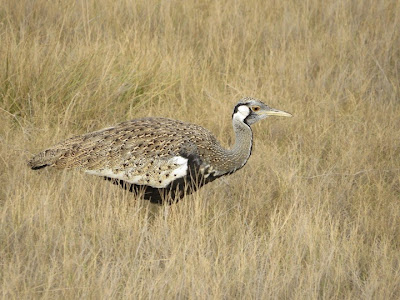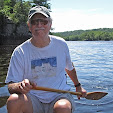From the Maasai Mara, we head southeast toward the last of our safari’s major wild game parks and reserves, Amboseli National Park.
Amboseli, like the Maasai Mara, is situated in the great Rift Valley, just before it spills into Tanzania. It, too, is governed by the local Maasai community. Though only 150 square miles, a fraction of the size of the Mara, it is Kenya’s second-most-popular wild game area.
The park is distinguished by its five major swamps, oases in an otherwise arid savannah landscape. While it claims to be home of the “big five” most-sought species of African wild game, it is best known for its large herds of free-ranging elephants.
 |
| PHOTO: Wikimedia Commons |
The park is also famous for its proximity to Mt. Kilimanjaro, just over the border in Tanzania. Here, the best—and luckiest—photographers capture those incredible shots of wildlife with the mountain as their backdrop.
Our base for this leg of the trip is the Sentrim Amboseli tented camp, just a few kilometers from the park entrance. As we step from our safari vans and stretch our legs, we're met by the entire staff singing us a cheery welcome song in Maa, the traditional language of the Maasai.
Even in Eden, life cannot be taken
for granted. Here, awareness is a
matter of life and death.
ELEPHANTS RULE
During our three game drives in the park, it soon becomes evident that elephants do, indeed, thrive here. They’re everywhere, and not just in the twos and fours we’d been seeing in the other reserves, but in the scores.
Often, we see them wading, knee-deep, in the lush wetlands, where they enjoy the best of all worlds, drinking, cooling off, and grazing on the tall grasses. We smile at the dark “socks” and “pants” they wear after emerging from the water.
Amboseli’s swamps also attract other animals. We’re struck by the variety: zebra, giraffe, wildebeest, rhinoceros, hippopotamus—a glimpse, it seems, of a beautiful, serene, timeless Eden. And yet we’re reminded that, even in Eden, life cannot be taken for granted. Here, awareness is a matter of life and death.
And the birds. Spectacular birds of every size and shape and color. I wonder if they're jealous of the animals for all the attention they get.
 |
| Go-away Bird |
 |
| Superb Starling |
 |
| Hartlaub's Bustard |
 |
| Crested Crane |
SEEING BEYOND SIGHT
Just before setting out on our last morning game drive, I walk by myself down our camp's long dirt path to a viewing platform. There you can take in a broad sweep of acacia-dotted savannah, and, if you’re lucky, Mt. Kilimanjaro in the background. I am not; the storied mountain is hiding today behind distant clouds.
Still, I’m not about to waste the moment, so I turn to other senses to experience the great peak’s presence. I sit down on the weathered bench and let go my need to see.
I feel close enough to the animals,
at times, to have been but barely
more predator than prey.
I close my eyes and bask in the delicious interplay of relentless equatorial sun, shreds of merciful shade from a big acacia tree, and a cool, dry breeze. I listen to the cheery banter of weaver sparrows on a branch just above.
Reaching out through that cocoon of visionless sensation, I will my mind’s eye across the miles, through the clouds, all the way to Kilimanjaro. Believing it’s there, imagining its countenance, I let the mountain into my vision even though I can’t see it.
 |
| PHOTO: Anna Langova |
Here I am, half a world away from home. Not just in Africa, but in the Rift Valley, the very cradle of the human species. At some level, I know this savanna, perhaps somewhere deep in my DNA. I feel my oneness with this place, and with large, wild animals—close enough to them, at times, to have been but barely more predator than prey.
I realize there's not a single man-made sound to be heard. Not a vehicle, an airplane, an air conditioner...not even the subtle background hum and hiss anyone within earshot of a highway must endure. And in that silence, I can hear Kilimanjaro.
The boy looks up, and, through the
cloud of dust, meets my wistful gaze.
THE SIMPLEST SONG
As if uneasy with the lull, the gentle breeze wafts a new sound over me. It’s a child’s voice, singing. Singing in the purest, sweetest notes I’ve ever heard, joyously, accompanied only by the crystalline cling—ting-ting of a small bell.
 I
turn my eyes’ vision back on. There, just across the camp’s perimeter
fence, a young Maasai boy, not yet old enough to have earned the full,
crimson-and-blue regalia of a warrior, tends—or should I say
entertains—his flock of goats as they amble off to a spot of shade for
the hottest hours of the day.
I
turn my eyes’ vision back on. There, just across the camp’s perimeter
fence, a young Maasai boy, not yet old enough to have earned the full,
crimson-and-blue regalia of a warrior, tends—or should I say
entertains—his flock of goats as they amble off to a spot of shade for
the hottest hours of the day.At the head of the flock trots a mottled orange-and-white nanny, not much different from the others, except that, under her neck, dangles that little bell.
The boy looks up, and, through the cloud of dust, meets my wistful gaze. He stops singing. I wave, and wish now I’d not seen him. He, like the great mountain, was more beautiful in just his simple song.







No comments:
Post a Comment